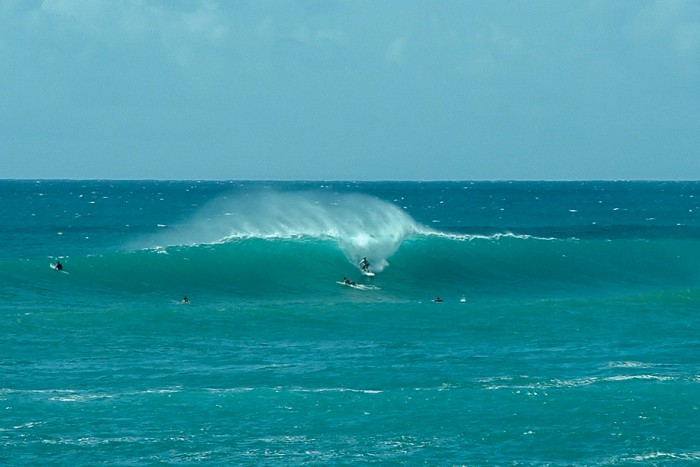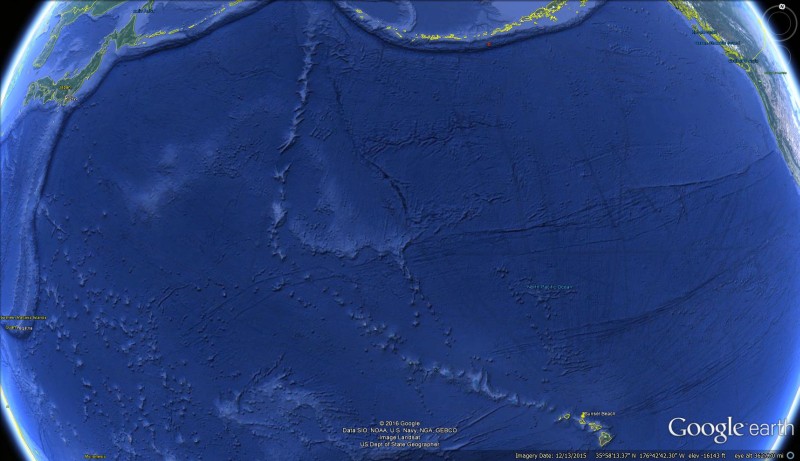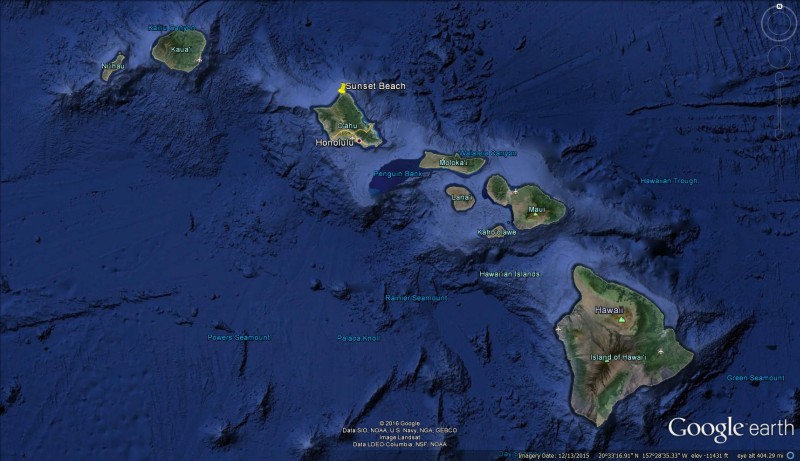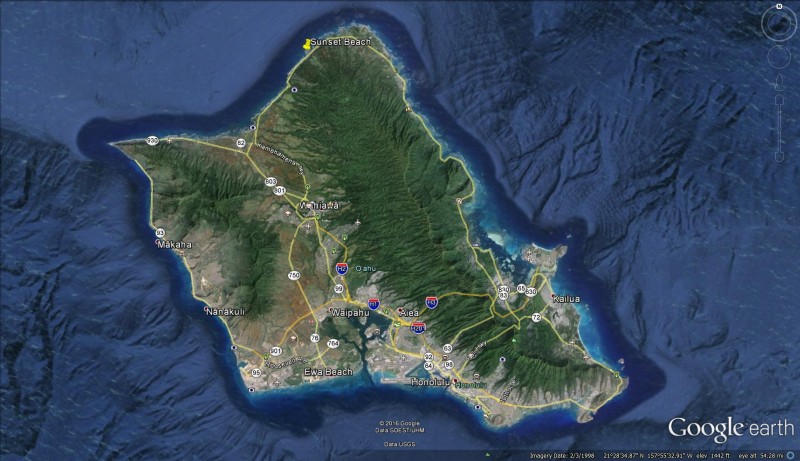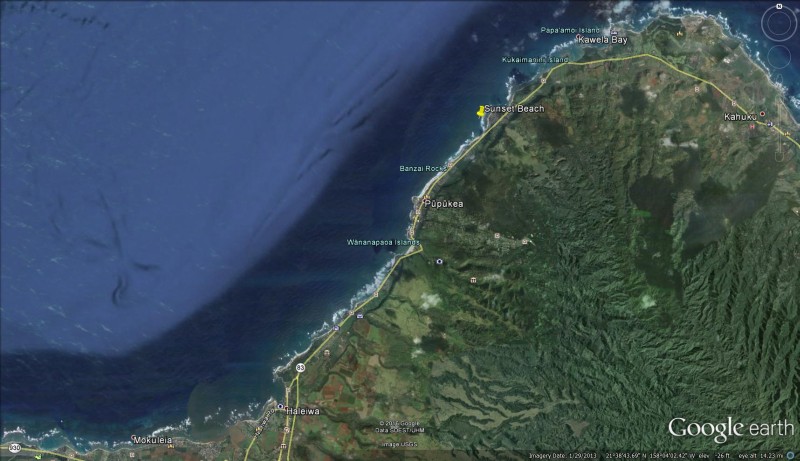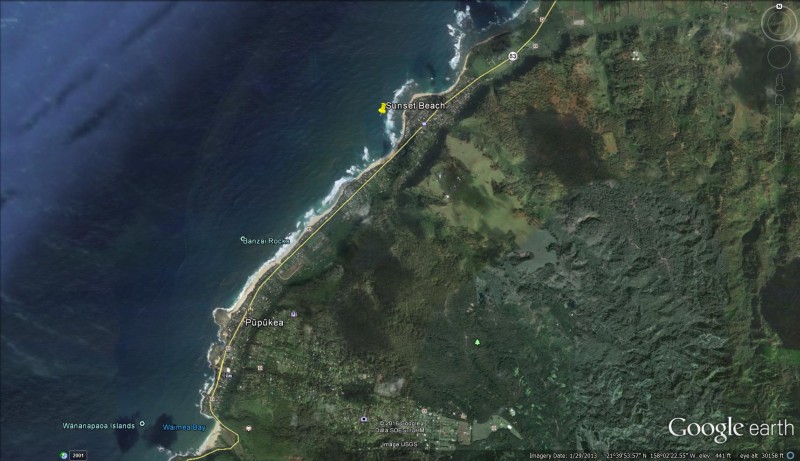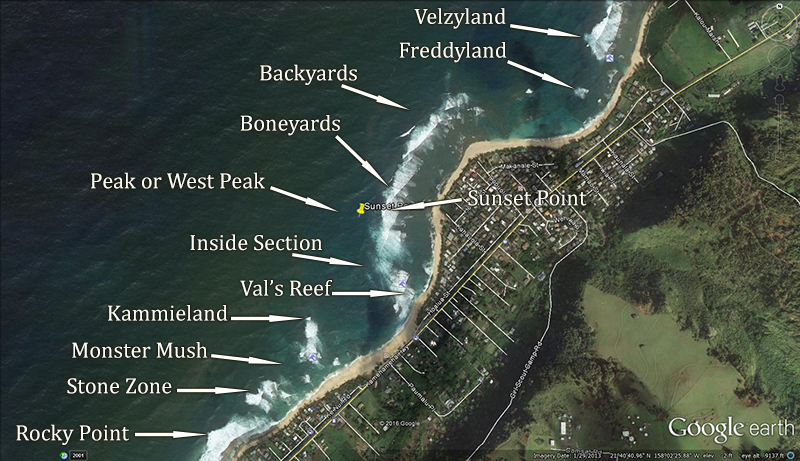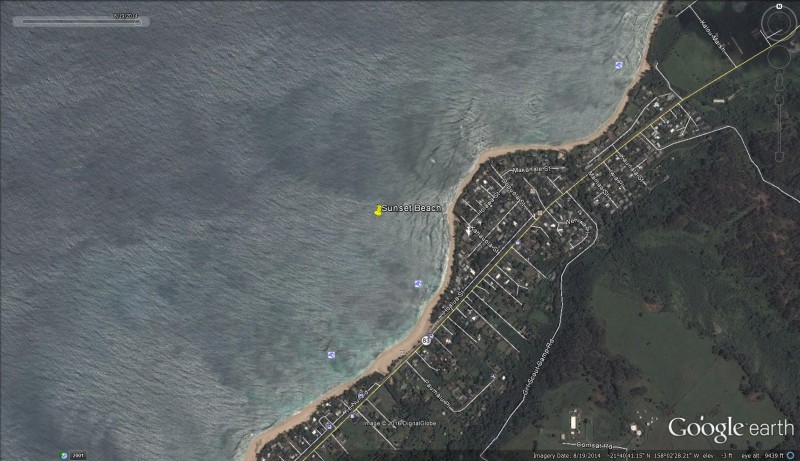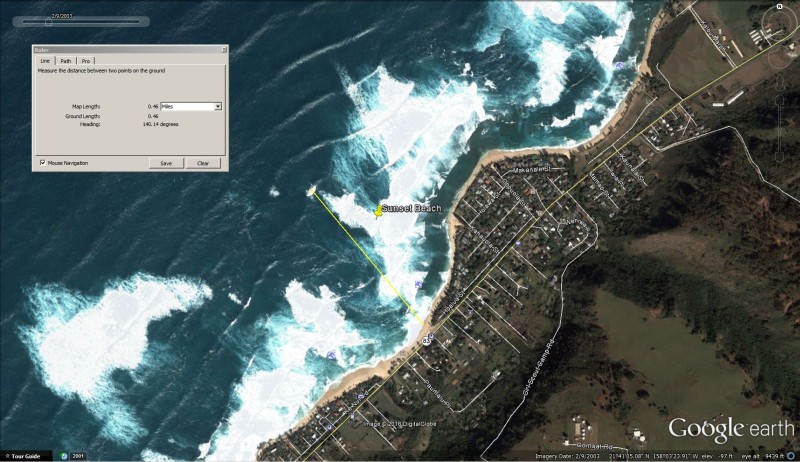How Does Sunset Beach Work? - Page 1
Wherein, I attempt to share a trifle of my limited understanding of the place with those who have not yet had the pleasure of dealing with The Best Wave in the World on personal terms.
In order to treat this topic with the care and respect which I believe it merits, there is going to be quite a lot by way of tangential background information that needs to be dealt with. I will digress on a regular basis. For those of you that dislike digressions, you have my apologies. But I know of no other way.
It's not enough for somebody to say, "Such and such." Who is saying it? What are their qualifications for saying it? Why are they saying it? How keen of an observer are they? What sort of experience with their chosen subject do they possess? Are they promoting some sort of agenda? If so, what might it be? And on and on and on. I shall try to deal with this end of things by sprinkling it in amongst the main narrative, but we must never forget that I am only one person, with only one pair of eyes, and only one set of experiences. Other people, with other eyes, and other experiences, will see and report something else.
To begin with, perhaps we should take a look at the very large arena that is Sunset Beach. We need to get a grip on the physical layout of the place itself, before we can continue on to the waves that break there, and what happens when those waves break.
Some surfspots, say Pipeline or perhaps Velzyland, have takeoff zones that are tightly defined, with a more or less "X marks the spot" aspect to them, which makes for an easier understanding of a thing that either "is" or "is not," and all extraneous considerations can be ignored while focusing on the item in question. Other surfspots sort of spread the takeoff zone out over a wider area, and strict inclusion and exclusion becomes a bit more problematic when it comes to choosing or defining that which gets included, and that which gets excluded.
Sunset Beach is one of the latter, and is actually several different spots, which all overlap to a greater or lesser degree, depending on things like size, swell angle, swell period, swell purity, tide, and generalized conditions on any given day.
For the purposes of what follows, I shall include within the overarching term "Sunset Beach," everything that happens from the shoreline to the outer reefs, between the channel that separates Kammieland from Sunset on one side, and Boneyards on the other side. Please note that Boneyards is really just an extension of the playing field at Sunset Beach, where waves can overlap in certain ways, so it's not like there's a channel or anything over on that side, ok? Whitewaters pour in from outside over in that area between Backyards and Sunset Beach, and the resulting right-handers can easily work their way through, as a perfectly makeable wave, across the top of the point, right on through Boneyards, and continuing right on into what is properly considered Sunset Beach. Occasional stray lefts can do the exact same thing, going in the opposite direction, but constitute a clear and present danger to anyone attempting to ride them all the way through, owing to the very-high-profile pillars and ridges of sharp coral which lurk just beneath the surface at Boneyards. Down farther below these words, as we step through the vicinity zooms, you'll see a photo of the general vicinity of Sunset Point, with labels, to kind of help get your bearings, but for all of the spots between Kammieland and Freddyland, please do not let the sharp points on the arrows fool you, ok? Things are much smudgier than that. Things exist in different places on different conditions. Things can overlap. It's a mess out there.
So it gets pretty tricky, right off the bat, ok?
And there will be plenty of people who will take issue with my inclusions and exclusions, and all the rest of it, and I suppose that I need to say, right up front, that there is nothing whatsoever that might be considered overarchingly authoritative about what I shall be writing, below.
It is simply my choice, my own personal way of trying to make sense of things, and nothing more. Please keep that in mind, ok?
Also, we're taking a trip back in time with this one.
My main experience with Sunset Beach runs for only four winters. Full winters to be sure, and all in a row, but still, only four, beginning in early Fall, 1972, and ending mid-Spring, 1976. My main surfing focus for that entire time was Sunset Beach, and I managed to learn a few small things, here and there, but really, it's not much. Sunset Beach is highly ramified and recondite although it may not look that way to a casual observer. A full lifetime could be spent delving into its nuances and secrets, and that would still not be nearly enough. As subjects for considered study go, Sunset Beach is extraordinarily wide, deep, and subtle. So I'm not the best reporter for this job, but I'll do the best I can, anyway.
I last personally dealt with Sunset Beach, in any form, on a couple of five to seven foot days, during a strange and unexpected doublet of freak out-of-season northwest swell, back on August 23, and again on August 25, 2004. Below, a picture I took just before paddling out on the twenty-third.
This is a photograph of small Sunset Beach. The wave has moved off the point, and is hitting on the peak, but only just. A close look at the water along the bottom margin of this photograph reveals there to be almost no rip at all. At Sunset Beach, no rip equals no waves. On this particular day, waves of this size were infrequent, coming in only on the larger sets, with very little happening in between. And this brings up a substantial digression: My own approach to surfing Sunset Beach, and everywhere else, for the most part, is one of paddling farthest outside and waiting the longest, trying to snag the most inconsistent, but very largest, set waves, and letting everything else go. This approach to wave selection must perforce color everything else that follows, and its impact on my ability to report things is both large and subtle. I experience much by selecting my waves this way, but there is much else that I do not experience, and cannot therefore speak about.
I have my reasons for doing things this way, and have been doing it all of my surfing life, but it is not within the scope of this essay to delve into all of the how's, why's, and wherefore's of it. For now, it is enough to know that, when it comes to catching waves, I was fortunate enough to be given more than a standard share of patience, and I am happy to employ my patience, waiting for that which must eventually come, even as all the others grow weary of the tedium and move back inside, looking to satiate their desires sooner instead of later.
In the end, I will only say that, from my own point of view, sitting inside at Sunset Beach is not recommended. I managed to get it wrong a few times, and that only served to reinforce my initial take on the matter.
Ok, back to the big picture. Back to the lineup.
We'll start from way back, and then zoom in. Sunset Beach is in Hawaii, which is just left of the word "Google," down in bottom right of the above image, and it's open to swells generated across more or less the entire North Pacific Ocean. During the winter, most swells come from the northwest, but anything from due west to northeast is possible, and aside from some shadowing by Kauai and Niihau, Sunset Beach is exposed to every bit of it.
Sunset Beach is on Oahu, which is north and west of everything in Hawaii except Kauai and Niihau.
Sunset Beach is near the northernmost point of Oahu, and owing to the normal direction of the trade wind, is one of the last clean spots before you go around the bend towards Kahuku and things get choppy. Sunset Beach has what is probably the best possible exposure to clean rideable winter swells on Oahu.
Traditional North Shore surfspots extend from Haleiwa to Velzyland, and Sunset Beach is near the northernmost end of things with only Backyards and V-Land being past it to the north.
There's Sunset Point, up near the top, with a yellow place marker pin giving its location. You're looking at the northern half of the North Shore. Waimea Bay is bottom left, and V-Land is above and to the right of Sunset Beach, tucked into a protected bay. Note the complete lack of whitewater at Waimea.
Close-up view of Sunset Point. Some things of note: Although it might look like there should be a point wave at Sunset Point, there is not. It tries, but because of the way the bottom profile farther outside bends the waves around, it never produces the type of long even wall required to spin down a point in an organized peeling manner. What you get instead, is peaks to a lesser or greater degree, that want to throw pretty good at first, but then oftentimes fade out instead of rifling down the point like Jeffreys Bay or somewhere like that. Judging by the look of the whitewaters in this image, it might have been nearly the same size as it was in the first image at the beginning of this essay, which was taken, as I've already mentioned, in August(!) of all weird months. Sunset wasn't really on the point, and it wasn't really on the peak, either. Velzyland, which is always smaller, might have been just about as perfect as it gets, which is so astoundingly perfect that I'd rather not talk about it right now, but then again, maybe not. The look of the swells outside in deep water hints at a bit of unevenness to things. Backyards has whitewater, but it too looks a bit uneven, although it's impossible to tell with any kind of confidence at all. Boneyards is breaking, but Boneyards always breaks, because it's literally only inches deep in places, but on this day it might have had a half-decent wave or two for those with little regard for their skin and muscle tissue. Past Sunset, headed southwest toward Haleiwa, Kammieland is breaking on the other side of the channel, and continuing on downcoast from there, Monster Mush looks like it's seeing a lull, Stone Zone is breaking, and so is Rocky Point.
During the summer, there's no surf at all for painfully long stretches of time. None. Dead flat. Day after day after day.
During the winter, it booms. I've placed a ruler between where the big West Peak is coming over, outside, and the shoreline you'd swim to if you lost your board taking off, or maybe getting cleaned up. It reads "0.46 Miles" and it's a rough-water swim, the whole way. Click on this image (and all the others, too) for a larger-size version, to see things better, if you'd like. Please note how the unbroken waves outside in this image are being warped around by variations in the depth profile of the bottom. It's this warping that gives Sunset Beach its distinctive peak, as what was once a single wall of water is bent around into a configuration where it converges against itself in the middle, giving the water in the wave that's just about to break nowhere to go but up. It's also what gives the place its alarming yet deceptive power. It oftentimes looks like a big mushball to the untrained eye. If you're off of the spot where the two "wings" intersect, they destructively interfere and weaken each other, and the wave just kind of flops over and then wants to back off right away. Get exactly on the spot where the wings are intersecting, and you get constructive interference, and the two wings strengthen each other, greatly I might add, and the lip of the wave will lunge thickly and vigorously forward and then detonate like a bomb. When it's big, you really do not want to get in front of it the wrong way because the energy release as it comes over is scarcely to be believed. Get in front of it the right way though, stroke into it and take the drop with a nice confident firmly-planted stance, or maybe even a little sketchily, and....... well....... that's some pretty goddamned nice stuff, right there.
In the next installment, we'll start talking more about the wave itself, or, more properly speaking, the waves themselves. At Sunset Beach there exists an entire array of them, and different ones show up at different times and places, and work in different ways. On top of that, you can start to factor in things like the rip, or whether the swell is rising rapidly, or maybe if it's got a pronounced or unusual angle to it, plus a substantial list of other factors and complications, and pretty soon it all adds up and you find yourself dealing with an overabundance of salient features to consider, even though you thought you were only asking a single question about a single thing.
That's just how Sunset Beach works, ok?
Return to 16streets.comMaybe try to email me? |
||
